#SSMS on Windows
Explore tagged Tumblr posts
Text
Install SQL Server Management Studio 20 on Windows Server
SQL Server Management Studio (SSMS) is a powerful tool for managing SQL infrastructure, from SQL Server to Azure SQL Database. In this guide, we shall discuss how to Install SQL Server Management Studio 20 on Windows Server. Please, see how to Upgrade VBR to 12.3.1: Setup detected inconsistent configuration, how to deploy and integrate VHR with VBR, and how to perform In-place upgrade of Windows…
#Install MSSQL Express Edition and SSMS#Microsoft SQL#Microsoft SQL Server Management Studio#Microsoft SQL Server Studio#SQL Server Management Studio (SSMS)#SSMS#SSMS on Windows
0 notes
Note
I SERIOUSLY love your writing ssm <33 and to me (ex-fanfic writer) it's impressive how well you do EVERYTHING. (REMEMBER TO TAKE BREAKS WHEN YOU NEED IT)
Sometimes im litch like "Oh my god. feelings. very well written and descriptive, and I relate to it. Great." and copy-paste it to my notes (I don't even use it for anything, it's just for like 'accurate stuff' 😭)
And uh. Off topic I hate windows 11 emojis. Except the devil one. Everything else is horrid.
But back to the point your writing is f fantastic. <3
The feelings pain me too haha 😭 I feel like you can clock everything about me based off my fics lol
Thank you so much for the compliments 🩷 means a lot to hear
3 notes
·
View notes
Text
Spider-Man Read-Through 058: Somebody is Killing Them All! (SSM 44-45, SSM Ann 2)
MASTERPOST

With a cover like that, you can only do one thing: keep reading.
(Plus, there's gorgeous art in there!)
And here's our awesome first page as well:

Wow. Just... wow. The lighting, the shading, the view... Incredible. Maybe needs more cars but come on, that's a detail. *reads the text* Oh...
The pages are very dense. Basically, the mob has had... issues recently (I wonder if Silvermane's part of it, like last time) and a guy wants his men to find some items for his uncle.
It's the New Year for Chinatown! One of the men, Dolenz, tries to steal the jade there, but he gets gunned down.
MEANWHILE.


I'm pregnant! But also, great colors in the second panel. And the third one. And I'm pregnant!


Look at his cute little outfit!!!!!!!! I love that red sweater, holy fuck!

Holy fuck. The food is good. The food is delicious.
So one of Peter's pictures features the aforementioned murder. Time to investigate!

It's Alfred's turn to die mysteriously. Not yet though, Spidey's still investigating!

First off, that joke is funny. Secondly, that cake in the last panel???!?! Yes but?!?! Maybe a bit too much hahaha.
Turns out Alfred doesn't die, on the contrary, his attackers die! What a chad.
The art is all over the place in this issue, but the line art is so good I don't even mind. Love how it all looks. And I feel like there's a lot of ambition too!

See what I mean?
Anyway, Spidey finds out that Malachai Toomes owns the building he was led to... Toomes, as in, the Vulture. He's a relative, nice!

What the fuck did the artists smoke for this issue, because they made excellent art, I love this!
Spidey fights goons, finds Toomes, who informs him that Alfred is the culprit, then tries to kill him with deadly gas coming out of his carnation. It's not the green, but it's still very gay.
Spidey wakes up chained in a coffin on a conveyor belt. And next to him...

Fucking hell, how the fuck is this issue so gorgeous like that?! Bravo to the whole team because goddamnit.
On *that* website, the commenters really don't like the art, but it's a scan and not digital, which I think does sublimate how it looked. Damn, I loved it.

What the fuuuuuck.
So Malachai is the Vulture's nephew, nice.
Everyone thinks Spidey's dead, so they have a celebration. Good for them!
The Vulture isn't fooled by Alfred's plans though. It was actually his intention all along to let Alfred get rid of his rivals to weed out the weak. Smart!
The furnace explodes or whatever, and Spidey gets everyone out of the burning mansion (but not before showcasing his perfect butt).
Elsewhere...

Damn, I liked that creepy little bald guy, I'll miss him.
The Vulture gets angry and starts pummeling Alfred, but then Spidey arrives, they fight, the Vulture flees, Alfred asks the cops to take him in to get protected from the Vulture.
Spidey and Vulture crash in Grand Central Station, it makes for a nice environment! Loving this. Eventually, the Vulture crashes in a glass window.
Peter... doesn't feel so good.

What a great set of issues. What a solid ending. Loved the art.
And now it's time for the King-Size Annual! I'm hoping for more of Peter's life, but somehow, I doubt it.

Sure!
Our story starts as Spidey and Rapier fight together against some low-level goons, before Rapier takes off. Alright, I'm up for a... team up.

They're staying mostly consistent with his apartment, that's nice! And while I appreciate our pretty hero, these pajamas look a bit weird. Also, it feels weird to see May!
The next day, Peter and Ned go to the docks to do some investigating.

Oh Ned, that outfit... *sigh*
The goons steal Peter's press card, and our heroes leave the area. However, when Peter goes to the Bugle (I have no idea why he would go to the Bugle but not matter) and is about to become gay for pay.

Oh, his "bulge ain't a billfold?" Huh-huh.
Just as I predicted previously, Silvermane's back, right in Jonah's office! He's unhappy about Jonah's inquiries about the mob, and the same goes for Peter's photographies. Silvermane himself gives the card back to Peter, nicely threatening him and taking his camera. Peter quickly gets an advance from Jonah though.

Hahaha.
They have a fight, and Spidey tells off Silvermane.

Silvermane's not amused.
We get a scene at the Rapier's home, where he says he must kill Silvermane and his girlfriend pleads for him to stop his vigilante activites. Standard stuff.
More importantly, Peter Parker is a slut (good for him).

So Jonah's idea is to make people so angry they rile up and the authorities are forced to act. Alright, not bad!
Glory informs Peter that Jonah's behavior is due to Robbie being recently attacked and sent to the hospital. Makes sense.
At a church turned into a museum or something, Silvermane has an appointment with Rapier. This is a great excuse to show great art.

Oh they're sooooo exes. They fucked, they absolutely fucked!
I'm afraid, because now that we got this character's backstory (they were partners, Silvermane left him for dead, Rapier's future girlfriend saved him, there you go) and now he can very well die. Silvermane is going to be alright, he's a villain, they always come back, but Rapier is (kind of) a nice guy now, and that's why I'm scared for him.
Spider-Man arrives right on time to stop Rapier from killing Silvermane, and Rapier's so angry he challenges Spidey to a sword fight. Hell yeah!

TOO MUCH TEXT CALM DOWN STAN LEE
Spider-Man gets rid of Rapier's sword, but then--Clarissa, Rapier's girlfriend, throws it at Spidey to make him confused! Nononono she's gonna die is she? Oh, I know she's gonna die. Come oooooooon.
Rapier feels betrayed by Clarissa's intervention, and decides to start ALL OF THIS ALL OVER AGAAAAAIN because he has PRINCIPLES. JESUS. OKAY.
So what must happen... happens.

Ugh. Alright, that's not a bad ending.
Except he's not dead! He flees the scene. Hm.

Ok, not sure I'm a fan of this Rapier guy. Feels too much like Punisher, but a bit more quirky. Maybe if he gets some development... Who knows!

We'll have to talk about this one commenter at some point because they have... opinions. They are very opiniated. And we're reading issues almost synchronized? This is funny. Dramaaaaaa. Lengthy comments every issue! Fascinating.
Next time: A lot of ASM! Like, a lot! We'll see how that goes.
2 notes
·
View notes
Text
IBM SSM Transformer Speed Performance With Bamba Model

IBM built “Bamba” by crossing a transformer and SSM. In collaboration with CMU, Princeton, and the University of Illinois, IBM Research created an open-source LLM that combines state-space model runtime performance with transformer expressiveness. Important enhancements are coming to IBM Granite 4.0.
IBM SSM
The transformer architecture of today's huge language models can create human-like writing. Self-attention, which allows the model to examine every word in an input sequence before responding, boosts its effectiveness.
The issue grows with prolonged talk. The model's memory retention of the ongoing sequence during response quadratically increases generation cost. Double the context window size and the cost of processing and responding quadruples. This “quadratic bottleneck” often delays model responses to queries. Duplicated computing is also produced. Before ChatGPT popularised the transformer in 2022, scholars were exploring for alternate architectures.
There are two possible answers.
IBM SSM layers with state-space models (SSMs) and transformers. IBM's first hybrid project, Bamba, can parse long sequences like a transformer and run as quickly as an SSM. It was just made public. A few months from now, IBM's Granite 4.0 machines will have Bamba's upgrades. Bamba-9B can run at least twice as fast as equivalent transformers while preserving accuracy by dramatically reducing KV (key value) cache memory demands. Everything depends on the IBM researcher leading the KV cache reduction initiative. Greater context duration, lower latency, and higher throughput. State-space models, the most important model you've never heard of, have been used to represent dynamic systems for decades but aren't as well known as transformers. They are crucial to robotics, control theory, signal processing, and electrical engineering. IBM researchers helped convert SSMs to deep learning. State-space models analyse time-series data in any discipline. SSMs can explain weather, stock markets, and brain electrical activity using mathematical calculations. An SSM uses observations to find a “hidden state” of a given size that captures the system's important properties. Consider the state a historical summary. The hidden state updates with future forecasts without increasing when fresh information arrives. SSMs evolved into neural networks in 2021 when Stanford academics Albert Gu and colleagues released S4, which used state variables to language. The transformer and RNNs before it and the SSM processed word sequences well. However, it handled long sequences faster and better than transformers and RNNs. SSMs compress historical data in a hidden state, whereas transformers process every word in the context window. Selective retention speeds up inference and reduces memory overhead. S4, which was difficult to build, surprised participants in Long Range Arena, a test for language models' ability to handle long sequences. Gupta, an IBM AI resident, helped Gu and his colleagues reduce the model with diagonal state spaces. The “diagonal” IBM SSM lowered S4's 1,000 lines of code to 10. After introducing a gating mechanism that filtered out irrelevant information, Gupta helped SSMs equal transformers' "expressivity," or sequence-modeling capacity, for the first time. That team revealed a possible first hybrid transformer. He investigated hybrids since he works on IBM's Granite Vision models. Text with local dependencies can be handled using standard attention blocks while leveraging SSMs for longer-range contextualisation. Tri Dao at Princeton and Gu, then a CMU professor, released the gated SSM variant Mamba2 in 2023, sparking a wave of hybrids like Samba and Mamba Former. Last year, Nvidia announced Nemotron-H after proving that these hybrids could speed up inferencing and surpass either architecture.
Overcoming KV cache bottleneck
IBM Research's Granite LLMs for enterprise have always prioritised efficiency. As IBM Granite expanded, researchers studied the quadratic bottleneck. IBM researchers built their own hybrid Bamba-9B after internal confirmation of Nvidia's findings. They used Nvidia's Mamba2 architecture and released practically all of Bamba's components open-source, including data, training recipes, IBM's data loader for large-scale distributed training, and a quantisation framework to decrease storage and inference costs. First, Bamba was trained with 2 trillion tokens—words and fragments. Motivated by the results, they decreased the model's bit width from Mamba2's 16-bit floating-point precision to 8-bits, added trillion tokens, and quantised it to reduce its size from 18 GB to 9 GB. Bamba matches Meta's Llama-3.1 8B model, which was trained on seven times more data, on crucial benchmarks because to its design and training data. SSM execution optimisation was their next problem with vLLM. The Bamba team worked together with Red Hat to integrate the model into the “virtual” LLM, the most popular open-source inference server for Large Language Models. SSMs require customised state management, making support difficult. Ganti requested the audience to enhance Bamba when it was published late last year. Bamba's Hugging Face introduction said, “Let's work together to overcome the KV-cache bottleneck.” After training on 4,000 token sequences, Bamba can handle 32,000 token conversations. Ganti said vLLM can reach one million tokens and function five times quicker than a transformer if it supports SSM.
#IBMSSM#IBMGranite#ChatGPT#KVcache#deeplearning#neuralnetworks#BambaModel#LargeLanguageModels#News#Technews#Technology#Technologynews#Technologytrends#govindhtech
0 notes
Text
How to Use AWS CLI: Automate Cloud Management with Command Line

Introduction
Briefly introduce AWS CLI and its significance.
Highlight its benefits: automation, efficiency, and ease of use.
Mention prerequisites for using AWS CLI.
1. Setting Up AWS CLI
Installation steps for Windows, macOS, and Linux.
Verify installation with aws --version.
Configure AWS CLI with aws configure.
2. Understanding AWS CLI Commands
Basic structure of AWS CLI commands.
Examples of commonly used commands (aws s3 ls, aws ec2 describe-instances).
3. Automating Cloud Management Tasks
Automating S3 bucket creation and file uploads (aws s3 cp).
Managing EC2 instances (aws ec2 start-instances, aws ec2 stop-instances).
Automating IAM user creation and permission assignments.
4. Using AWS CLI with Shell Scripting
Writing a basic shell script for AWS automation.
Scheduling scripts using cron jobs or Windows Task Scheduler.
5. Advanced AWS CLI Features
Using AWS CLI with profiles and multiple accounts.
Filtering and formatting output (--query, --output).
Using AWS CLI with AWS Systems Manager (SSM).
6. Troubleshooting Common Issues
Handling authentication and permission errors.
Debugging with --debug flag.
Conclusion
Recap of key AWS CLI features.
Encourage readers to explore AWS CLI for automation.
WEBSITE: https://www.ficusoft.in/aws-training-in-chennai/
0 notes
Text
Các công cụ cần có để quản trị VPS Windows hiệu quả
VPS Windows là một trong những lựa chọn phổ biến cho doanh nghiệp và cá nhân cần một môi trường máy chủ mạnh mẽ, dễ quản lý. Tuy nhiên, để vận hành VPS Windows hiệu quả, bạn cần trang bị các công cụ hỗ trợ giúp giám sát, t���i ưu hiệu suất và bảo mật hệ thống. Trong bài viết này, chúng ta sẽ cùng khám phá những công cụ cần thiết để quản trị VPS Windows hiệu quả nhất.
Công cụ giám sát hiệu suất VPS Windows
Task Manager: Task Manager là công cụ mặc định của Windows giúp theo dõi tài nguyên hệ thống như CPU, RAM, ổ đĩa và mạng. Đây là công cụ cơ bản nhưng rất quan trọng để quản lý hiệu suất VPS.
Resource Monitor: Resource Monitor cung cấp cái nhìn chi tiết hơn về các tài nguyên hệ thống đang được sử dụng, giúp bạn phân tích các tiến trình đang chạy, mức độ sử dụng bộ nhớ và dung lượng ổ cứng.
Performance Monitor: Performance Monitor cho phép bạn tạo biểu đồ và báo cáo chi tiết về hiệu suất hệ thống theo thời gian thực, giúp theo dõi các thông số quan trọng như tốc độ CPU, mức sử dụng RAM và hiệu suất đĩa cứng.
Công cụ quản lý từ xa
Remote Desktop Connection (RDP): Remote Desktop Connection là công cụ mặc định của Windows, giúp bạn kết nối và quản lý VPS Windows từ xa một cách dễ dàng.
AnyDesk: AnyDesk là một phần mềm điều khiển từ xa nhẹ, tốc độ nhanh và bảo mật cao, giúp bạn truy cập VPS Windows từ bất kỳ đâu.
TeamViewer: TeamViewer là một công cụ phổ biến khác để kết nối và quản lý VPS từ xa, phù hợp cho những ai cần hỗ trợ kỹ thuật hoặc quản trị nhiều máy chủ cùng lúc.
Công cụ bảo mật và quản lý tường lửa
Windows Defender Firewall: Windows Defender Firewall là giải pháp tường lửa tích hợp trong Windows, giúp ngăn chặn các cuộc tấn công và bảo vệ hệ thống khỏi phần mềm độc hại.
Bitdefender GravityZone: Bitdefender cung cấp giải pháp bảo mật mạnh mẽ giúp bảo vệ VPS khỏi virus, malware và các mối đe dọa trực tuyến.
Snort: Snort là một hệ thống phát hiện xâm nhập (IDS) mạnh mẽ, giúp phát hiện và ngăn chặn các cuộc tấn công mạng vào VPS Windows.
Công cụ sao lưu và phục hồi dữ liệu
Windows Server Backup: Windows Server Backup là công cụ sao lưu miễn phí tích hợp sẵn trên Windows Server, giúp bạn sao lưu và khôi phục dữ liệu nhanh chóng.
Veeam Backup & Replication: Veeam là một trong những phần mềm sao lưu hàng đầu, hỗ trợ sao lưu định kỳ và khôi phục dữ liệu dễ dàng trên VPS Windows.
Acronis Cyber Protect: Acronis cung cấp giải pháp sao lưu dữ liệu toàn diện, giúp bảo vệ VPS khỏi các sự cố hệ thống hoặc mất dữ liệu do tấn công mạng.
Công cụ quản lý cơ sở dữ liệu
Microsoft SQL Server Management Studio (SSMS): SSMS là công cụ mạnh mẽ giúp quản lý cơ sở dữ liệu SQL Server trên VPS Windows, cung cấp giao diện trực quan và nhiều tính năng hữu ích.
MySQL Workbench: Nếu bạn sử dụng MySQL trên VPS Windows, MySQL Workbench là công cụ không thể thiếu để quản lý, thiết kế và tối ưu hóa cơ sở dữ liệu.
phpMyAdmin: phpMyAdmin là công cụ web-based giúp quản lý cơ sở dữ liệu MySQL trên VPS Windows dễ dàng thông qua trình duyệt.
Công cụ tối ưu hóa và dọn dẹp VPS Windows
CCleaner: CCleaner giúp dọn dẹp file rác, registry lỗi và tối ưu hóa hệ thống để VPS Windows hoạt động nhanh hơn.
Process Explorer: Process Explorer là công cụ thay thế Task Manager, cung cấp thông tin chi tiết về các tiến trình đang chạy trên VPS.
WinDirStat: WinDirStat giúp phân tích dung lượng ổ cứng, tìm kiếm và xóa các file chiếm nhiều không gian trên VPS.
Công cụ quản lý web server
IIS Manager: IIS Manager là công cụ quản lý dịch vụ web server trên Windows, giúp thiết lập và cấu hình website chạy trên VPS.
XAMPP: XAMPP cung cấp môi trường máy chủ web gồm Apache, MySQL, PHP, rất hữu ích cho việc phát triển và kiểm tra ứng dụng web trên VPS Windows.
Docker for Windows: Docker giúp triển khai và quản lý các ứng dụng container trên VPS Windows, hỗ trợ xây dựng môi trường phát triển linh hoạt.
Kết luận
Việc quản trị VPS Windows hiệu quả không chỉ phụ thuộc vào kỹ năng của quản trị viên mà còn cần đến sự hỗ trợ của các công cụ phù hợp. Từ giám sát hiệu suất, bảo mật, sao lưu dữ liệu đến tối ưu hóa hệ thống, mỗi công cụ đều đóng vai trò quan trọng trong việc đảm bảo VPS hoạt động ổn định và an toàn. Hãy lựa chọn và kết hợp các công cụ trên để quản trị VPS Windows một cách chuyên nghiệp và hiệu quả nhất.
Tham khảo thêm: https://vndata.vn/vps-windows-gia-re/
0 notes
Text
Program SSm Pengangkut dan Single Billing Disosialisasikan ke Agen Kapal di Kendari
SULTRATOP.COM, KENDARI – Untuk mempermudah layanan kapal, program Single Sub-Mission (SSm) pengangkut dan single billing disosialisasikan kepada para agen kapal yang ada di Kota Kendari, Sulawesi Tenggara (Sultra) pada Senin (22/7/2024) di salah satu hotel di Kendari, sekaligus pelaunchingan single billing pelabuhan Kendari. Kepala Seksi Lembaga Nasional Single Window Edwin mengatakan, program…
0 notes
Text
So, I've eliminated a few paths already. One has nice examples that the author says are scripts. They're not Batch commands. If they're PowerShell, I don't have the right module (and it doesn't look right to my untrained eye). So what are they? Another was supposedly learning to use ScriptDOM, but no explanation of what to create is included. Maybe I'm too inexperienced to understand some stuff, but if you don't include at least a file type I'm fairly sure you skipped something.
So I'm trying this. It's worth a shot. First step, have a database project in VS. Uhm... I've never done that. I know why we should. But my work has a history of not requiring programmers to document what we do on production systems. Finally got the server admins doing it a while ago, but folks like me live dangerously. Grumble.
So - step 1, create a database. It's not a listed step, but apparently you don't do the creation in VS. There's no step for it in the template listing at least.
So instead I'm doing https://medium.com/hitachisolutions-braintrust/create-your-first-visual-studio-database-project-e6c22e45145b
Step one: in SSMS run the command:
CREATE DATABASE TCommon
T for temporary, and Common is a database I've already got going. It's for non-secure tools/programs/etc. that any of the other databases should be able to access.
Now to start up VS 2022. We begin a new project and search for database templates.
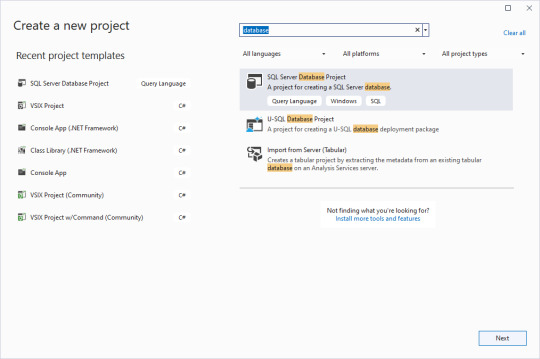
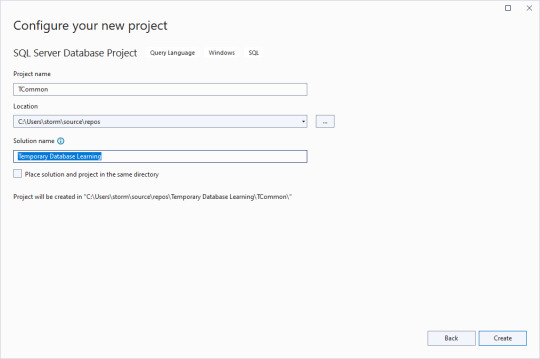
Clear the checkbox for putting the solution and project in the same directory, and give an overarching name to the solution. That way you can have multiple database projects worked on inside of one solution.
Next, we import the blank database so we have a test bed based off what is in production. Right click on the solution name, select Import, then Database.

The import database wizard looks like this after the connection is set.

Blackburn suggests that you turn off the importation of referenced logins so you don't accidentally alter permissions. Sound strategy.
Then you can click on the "Select Connection" button.
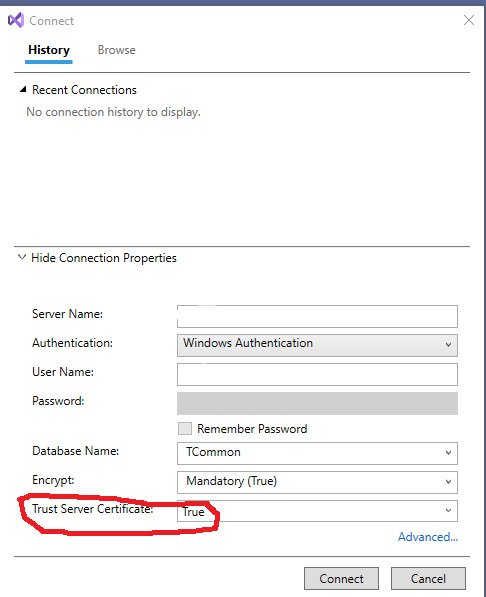
On my workstation, I have to Show Connection Properties, then change the default for Trust Server Certificate to True for it to make a connection. I'm running a test version of SQL Server and didn't set up the certificates.
Click on Connect. Then on the Import Database window, click Start.

With a blank database, it's fairly anticlimactic, but there really is a connection now to the database, and the properties are copied to your work area. The summary tells you where the log is stored. Then click "Finish" to continue on.
Next, we'll add some objects in. Right click in the Solution Explorer pane, then click Add, then New Item. Lots of little goodies to play with. Since I've been trying to match a project from another site, I need to create a schema to store the objects in. Schemas are part of Security, and there's my little object. I select the schema, give it a name down below, and click Add.
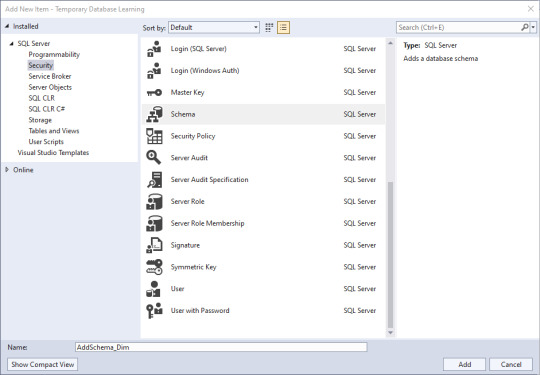
Well, not quite what I expected to happen: CREATE SCHEMA [AddSchema_Dim]

But that's changeable. And in making that change, the solution's object has the name I wanted, and the code has the actual name of the schema I want.
Now, lets add a table.
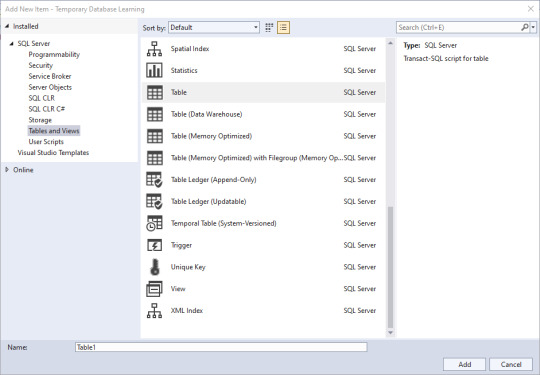
If you're like me, you've used a few of these, but not all of them. Time to do research if you're unsure, but I'm going to go with a simple table for this demonstration. Since I know the name of the solution object will take the name I put in the bottom, I'll name this one AddTable_Dim.Date, and know that I need to edit the actual code.
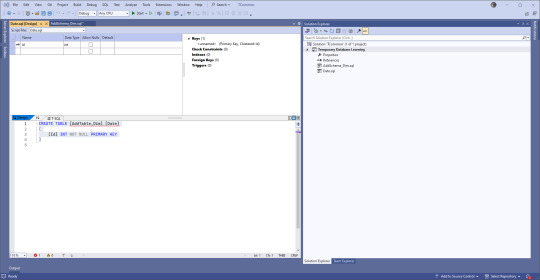
You have choices. If you're used to creating tables using the upper part of the pane where there is a GUI type of set up, go for that. If you're used to typing things out, go to the lower part. Or mix and match! VS will keep the two in sync.
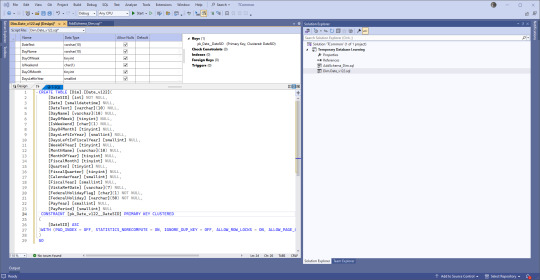
Instead of 'ID' we use 'SID' for Surrogate Identifier. The intake process sets up the unique (across a table) SID values and follows rules that help us track issues backwards to the original location where the data came from.
Second, there's a version number in there. We have the same tables across various enclaves (groups of servers), and we keep the versions the same between all but our development enclave. But instead of forcing our developers and end users to keep up, we use views that are in the databases they work from to expose the data. Many times we don't need to change the views at all which is easier on people that don't need to memorize a few hundred tables and variations.
I'm going to cut this off here, and start working on the next post. Back soon!
0 notes
Text
Unlocking the World of SQL: A Beginner's Tutorial for Programming Novices
Introduction
Welcome to the world of SQL, where data meets structure, and queries reign supreme! If you're new to programming or just dipping your toes into the vast ocean of data management, SQL (Structured Query Language) is your gateway. In this beginner's tutorial, we'll take you through the fundamentals of SQL in the simplest terms possible, empowering you to navigate databases with confidence.
Understanding SQL: What is it?
SQL, pronounced as "sequel" or sometimes as individual letters S-Q-L, is a specialized programming language designed for managing and manipulating relational databases. Its primary function is to communicate with databases to perform tasks such as retrieving data, updating records, and performing various operations.
Setting Up: Tools You Need
Before diving into SQL, you'll need the right tools. Fortunately, there are several user-friendly options available for beginners. You can opt for SQL Server Management Studio (SSMS) for Windows users, or MySQL Workbench for a cross-platform solution. Both provide intuitive interfaces for writing and executing SQL queries.
The Basics: Syntax and Structure
SQL follows a structured syntax that resembles natural language, making it relatively easy to understand. A typical SQL statement consists of keywords (e.g., SELECT, FROM, WHERE), clauses, and expressions. For example, to retrieve data from a table, you'd use the SELECT statement followed by the column names and the FROM clause specifying the table name.
Data Manipulation: CRUD Operations
In SQL, CRUD stands for Create, Read, Update, and Delete – the four essential operations for managing data.
Create: Use the INSERT statement to add new records to a table.
Read: Retrieve data using the SELECT statement.
Update: Modify existing records with the UPDATE statement.
Delete: Remove records from a table using the DELETE statement.
Retrieving Data: The SELECT Statement
The SELECT statement is SQL's powerhouse for fetching data from databases. It allows you to specify which columns you want to retrieve and apply filters to narrow down the results. For instance, SELECT * FROM Employees fetches all columns from the Employees table, while SELECT FirstName, LastName FROM Employees retrieves only the specified columns.
Filtering Results: The WHERE Clause
The WHERE clause enables you to filter data based on specified conditions. It allows you to retrieve records that meet specific criteria, such as selecting employees with a salary greater than $50,000 or customers from a particular city. The syntax is straightforward: SELECT * FROM Employees WHERE Salary > 50000.
Sorting and Grouping: ORDER BY and GROUP BY
To organize your query results, SQL offers the ORDER BY clause, which arranges the output in ascending or descending order based on specified columns. For example, SELECT * FROM Employees ORDER BY Salary DESC sorts employee records in descending order of salary. Additionally, the GROUP BY clause groups rows sharing common values into summary rows, often used with aggregate functions like COUNT, SUM, AVG, etc.
Joins: Combining Data from Multiple Tables
One of SQL's most powerful features is its ability to combine data from different tables using JOIN operations. Joins allow you to establish relationships between tables and retrieve related information in a single query. Common types of joins include INNER JOIN, LEFT JOIN, RIGHT JOIN, and FULL JOIN, each serving different purposes based on your data requirements.
Practice Makes Perfect: Exercises for Mastery
The best way to solidify your understanding of SQL is through hands-on practice. Try creating sample databases and writing queries to perform various tasks. Websites like LeetCode, HackerRank, and SQLZoo offer interactive exercises and challenges tailored for beginners. Additionally, consider working on real-world projects or contributing to open-source databases to apply your newfound skills in practical scenarios.
Conclusion
Congratulations! You've unlocked the door to the fascinating world of SQL. With a solid understanding of its fundamentals, syntax, and essential operations, you're well-equipped to manipulate data and extract valuable insights from databases. Remember, practice and persistence are key to mastering any programming language, so keep experimenting, exploring, and honing your SQL skills. Happy querying!
0 notes
Text
How to install Endpoint Configuration Manager on HyperV VM
Microsoft integrates Configuration Manager into the Intune family of products, offering an integrated solution for managing all devices. This integration simplifies licensing and eliminates the need for complex migrations. Users can continue leveraging their existing Configuration Manager investments while tapping into the capabilities of the Microsoft cloud at their own pace. This is a…

View On WordPress
#ConfigMgr#Configuration Manager#ECM Installation#Extend Active Directory AD Schema#Microsoft Endpoint Configuration Manager#Microsoft SQL Server Management Studio#Microsoft Windows#SQl Server 2022#SQL Server Management Studio#SQL Server Management Studio (SSMS)#Windows#Windows 10#Windows 11#Windows ADK#Windows Server#Windows Server 2012#Windows Server 2016#Windows Server 2019#Windows Server 2022#Windows Server 2025
0 notes
Text

window 04:30 commission SSM(22.5x22.5cm) oil on canvas, 2024
1 note
·
View note
Text
Spider-Man Read-Through 052: The Arms of Doctor Octopus (ASM Ann 13, SSM Ann 1)
MASTERPOST
First off: Annual 13 of ASM, and then the first SSM annual! And it's focused on Octopus. Alright...

The strangest Spidey story? We've had a LOT of stuff already so let me doubt that assertion, hahaha.
Our story begins with strange, apparently unlinked scenes, until some strange man asks Spidey to investigate a colleague's death.

At Blake's funeral, Peter sees that his wife thinks he didn't kill himself. The same night, the strange man comes to his apartment and correctly identifies Peter as Spidey. Hm!
The issue is very dense so I'm not giving details, but Peter joins the bad guys sporting facial hair (that are probably fake?).

Not a bad look!
Meanwhile, Doc Ock's also looking for something... or rather, someone.

Octavius finds undercover!Peter and the goons and outs him in front of them, and while Octavius gets the information he needed, Peter gets thrown in the sea. He resurfaces and the mystery man (probably from SHIELD) helps him out and gives him Ock's location, saying he needs Jimbo Ryan.
Ock finds Ryan and is about to retrieve his secret documents, but Spidey arrives and they fight. The mystery man (apparition?) appears to Ryan and Ryan, scared, falls off, but...

This is nice!
Blake's killer is saved and given to the police, but Ock gets away and when Peter goes back to Blake's wife...

Well well well.
That's how this issue ends. In the following pages, we see Spidey's "most famous foes". The first one is the Looter/Meteor Man (who appeared mostly in ASM 36 so who even is that), but more importantly...

My boy gets a page too <3
They also showcase Peter's current apartment, as well as his current and upcoming cast.

That's a nice idea! Would definitely have dug this, younger. Well, even now, honestly...
SSM Annual #1 (those numberings are starting to feel stupid) starts with a great page:

Honestly, the art was pretty good in the previous issue.
Ock is suffering big time at his lair, being operated on to diminish his pain.
Meanwhile, after helping some citizens with the storm, Spidey finds the metal arm he tore from Ock and takes it to ESU to study it. He meets Marcia Kane who totally isn't a Gwen Stacy ripoff and they have an "amiable" talk.
The arm activates itself, attacks Peter and flies out the window, but not before our hero throws a Spidey-signal on it to later follow it to Ock's lair. It was a trap, however! And the two enemies fight each other on a boat.
Spidey eventually gets thrown into the sea (AGAIN!), and emerges...

The Octosphere. Pfft. Okay. Sure. The logo feels very Hydra-esque.
The fight continues on a nuclear submersible...

Alright ¯\_(ツ)_/¯
See you next time, space cowboy!
3 notes
·
View notes
Text
AI21 Labs’ Jamba 1.5 Models Available On Amazon Bedrock

Amazon Bedrock now offers the AI21 Labs Jamba 1.5 models.
Jamba 1.5 family
We are pleased to inform that Amazon Bedrock now offers the potent new Jamba 1.5 family of large language models (LLMs) from AI21 Labs. With these models, long-context language capabilities have advanced significantly and are now more performant, fast, and useful for a variety of applications. Two variants in the Jamba 1.5 family are the Jamba 1.5 Mini and Jamba 1.5 Large. Both models allow the consumption of document objects, function calls, and a 256K token context window with structured JSON output.
Building foundation models and artificial intelligence (AI) systems for the enterprise is a specialty of AI21 Labs. By working strategically together, AI21 Labs and AWS are enabling clients in a variety of industries to develop, implement, and grow generative AI systems that address pressing issues and spur creativity. Customers may use LLMs in a safe setting to influence how people process information, communicate, and learn going forward by utilizing AI21 Labs’ cutting-edge, production-ready models in conjunction with Amazon’s specialized services and robust infrastructure.
What is Jamba 1.5?
The transformer model architecture and Structured State Space model (SSM) technology are combined in a novel hybrid architecture used by Jamba 1.5 models. With this novel method, Jamba 1.5 models can manage lengthy context windows up to 256K tokens while retaining the high-performance features of conventional transformer models. This hybrid SSM/transformer architecture is covered in greater detail in the whitepaper Jamba: A Hybrid Transformer-Mamba Language Model.
Amazon Bedrock now supports two new Jamba 1.5 models from AI21:
Jamba 1.5 Large: Jamba 1.5 For applications that demand high-quality results on both long and short inputs, Large is the perfect choice because it performs exceptionally well on complex reasoning tasks across all prompt lengths.
Jamba 1.5 Mini: Fast examination of large documents and data is made possible by Jamba 1.5 Mini’s low-latency processing of long prompts.
The Jamba 1.5 models’ main advantages are as follows:
Extended context handling – Jamba 1.5 models, with their 256K token context length, can enhance the performance of enterprise applications, including extensive document summarizing and analysis, as well as agentic and RAG workflows.
Multilingual: Hebrew, Arabic, German, Dutch, Spanish, French, Portuguese, Italian, and English are all supported.
Friendly to developers: It can automatically handle structured JSON output, invoke functions, and process document objects.
Efficiency and speed: AI21 evaluated the Jamba 1.5 models, reporting that the models outperform other models of similar sizes by up to 2.5X when it comes to inference on lengthy contexts.
Start using Jamba 1.5 models on Amazon Bedrock now
To begin using the new Jamba 1.5 models, navigate to the Amazon Bedrock console, select Model access from the pane on the bottom left, and submit a request to access Jamba 1.5 Small or Jamba 1.5 Large.Image credit to AWS
Select the Text or Chat playground from the left menu pane in the Amazon Bedrock dashboard to test the Jamba 1.5 models. Next, click Select model, choose AI21 as the category, and choose between Jamba 1.5 Mini and Jamba 1.5 Large for the model.
AWS SDKs can be used to access accessible models, and you can use a variety of programming languages to develop your apps.
For use cases like paired document analysis, compliance analysis, and lengthy document question-answering, the Jamba 1.5 models are ideal. They can effortlessly process lengthy or complex papers, evaluate data from several sources, and determine if passages adhere to particular rules. The AI21-on-AWS GitHub repository contains sample code. Visit AI21’s documentation to find out more about efficiently prompting Jamba models.
Presently accessible
Currently, the Jamba 1.5 model family from AI21 Labs is widely accessible in the US East (North Virginia) AWS Region’s Amazon Bedrock. Visit the AI21 Labs in Amazon Bedrock product and pricing pages to find out more.
Read more on govindhtech.com
#AI21Labs#Jamba15Models#AmazonBedrock#Jamba15Large#Amazon#pricingpages#generativeAi#AI21documentation#Buildingfoundation#technology#technews#news#govindhtech
0 notes
Text
Data is the foundation of successful businesses in today's linked digital landscape, driving everything from decision-making procedures to consumer interactions. Organizations heavily rely on powerful database management systems to fully utilize the value of data. Microsoft SQL Server, MySQL, and MongoDB stand out among the many solutions available as three well-known names. These database systems are essential for organizing, retrieving, and storing data; yet, they each go about this in a different way and have different advantages and disadvantages.
This blog is to uncover the complexities of these three database juggernauts, comprehending what makes them special and how they cater to various needs.
Microsoft SQL Server
A game-changer in relational databases. Robust, reliable, and feature-packed, it drives apps from small projects to enterprise solutions. Join us to unveil its magic—data storage, retrieval, performance, and security.
Hardware:
Running on Windows-based hardware, Microsoft SQL Server is a dependable relational database management system (RDBMS). It can be installed on a variety of hardware arrangements, including single-server systems and clusters of powerful servers. For the best speed while processing big datasets and difficult queries, it makes use of multi-core computers, lots of RAM, and quick storage systems.
Software:
The Windows operating system-based Microsoft SQL Server has a number of editions, each suited to a particular purpose, including the Express, Standard, and Enterprise editions. In addition to SQL Server Management Studio (SSMS), Integration Services, Analysis Services, and Reporting Services, it offers a range of tools for database management. These resources support database creation, upkeep, and business intelligence.
Procedure:
For data administration and manipulation, Microsoft SQL Server adheres to the Structured Query Language (SQL) standards. SQL commands are used by users to create, update, and retrieve data. In order to improve data security and integrity, it offers stored processes, triggers, and functions for procedural logic. To maintain data availability and reliability, SQL Server also provides sophisticated tools including replication, backup and recovery, and failover clustering.
Data:
SQL Server maintains the consistency and integrity of the data by storing it in relational tables with established schemas. It supports ACID transactions, which ensure that database operations are carried out trustworthily. ACID stands for Atomicity, Consistency, Isolation, and Durability. Additionally, SQL Server makes it possible to build intricate connections between tables, which makes it easier to get and analyze data quickly.
MySQL
Is an open-source relational database management system, consists of key components that drive its functionality:
Hardware:
Popular open-source relational database system MySQL is compatible with Windows, Linux, and macOS in addition to other hardware systems. It is a versatile option for both small-scale applications and large-scale systems because it is designed to operate effectively even on basic hardware configurations.
Software:
The Community Edition and the Enterprise Edition are the two primary editions of MySQL's core system. While the Enterprise Edition offers extra tools and assistance, the Community Edition is open-source and delivers necessary features. A graphical tool called MySQL Workbench makes it easier to create, manage, and develop queries for databases.
Procedure:
Similar to Microsoft SQL Server, MySQL too employs SQL to manipulate data. Using SQL commands, users can create, change, and query databases, among other things. MySQL offers user-defined functions, stored procedures, and triggers, enabling programmers to incorporate unique logic inside the database. To improve data availability and fault tolerance, it provides replication and clustering functions.
Data:
Structured tables with predefined schemas are used by MySQL to store data. It is well renowned for performing well in read-intensive situations, making it appropriate for applications that call for quick data retrieval. Because MySQL supports ACID transactions, data consistency and durability are guaranteed. Additionally, it supports many storage engines, including InnoDB and MyISAM, each of which is tailored for a particular use case.
MongoDB
A popular NoSQL database, operates through essential components that define its functionality:
Hardware:
Leading NoSQL database system MongoDB was created to manage unstructured or partially organized data. It can be installed on a variety of hardware setups, including cloud-based settings and common hardware. The architecture of MongoDB is adaptable and can extend horizontally to handle expanding datasets.
Software:
MongoDB has both a community edition and an enterprise version, and it functions as a distributed database. MongoDB is accessed by developers through drivers tailored to their chosen programming languages. A graphical tool called MongoDB Compass facilitates query exploration and database management, making it simpler to work with the document-oriented approach.
Procedure:
The flexible schema-less method used by MongoDB differs from that of conventional RDBMS systems. Data is kept as groups of documents that resemble JSON. Users work with MongoDB by performing CRUD (Create, Read, Update, Delete) actions on documents using the MongoDB Query Language (MQL). Due to its nature, MongoDB is a good choice for applications that need quick and agile development cycles.
Data:
Documents, which can have different structures inside the same collection, are how MongoDB stores data. As data develops, this enables increased flexibility and agility. MongoDB offers sharding, which distributes data across different servers, to enable horizontal scaling. In its "eventual consistency" concept, availability is prioritized over consistency.



Blog by: Clarence Manulat
1 note
·
View note
Text
Change SQL Server Management Studio default user saved as window authentication
Change SQL Server Management Studio Window Authentication to domain user Problem: I am not able to change the disabled username in the window authentication mode in SSMS ( SQL Server Management Studio) If you want to change the SQL Server Management Studio Authentication user which running on Window Authentication. Tried solution but failed I tried to update or delete these entry to…

View On WordPress
0 notes
Text
Tema Escuro no SSMS - SQL Server Management Studio
Como habilitar dark theme no SQL Server Management Studio.
Muita gente não sabe, mas o SSMS – SQL Server Management Studio, atualmente em sua versão 19.1 (Jan/2023), possui tema escuro assim como Visual Studio e o próprio Windows. Acontece que, por ainda estar em desenvolvimento, esta opção vem desabilitada por padrão na interface do programa. Vou aqui dar a dica de como habilitar tal recurso e como otimizar sua utilização. É necessário fazer uma…

View On WordPress
0 notes